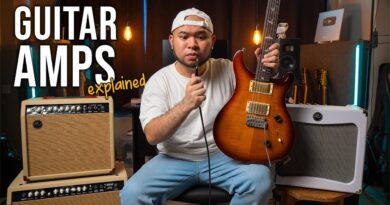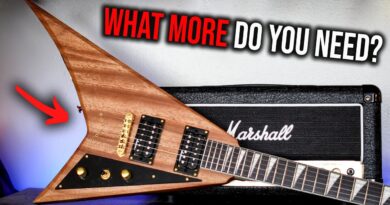7 Easy Ways to Improve Your LIVE Guitar Sound
Live sound can be tricky. Here are some tips to make sure that your live guitar sound is as good as it can be, so that you can get on with enjoying your performance with an inspiring guitar sound.
– Alpine Earplugs
USA: https://amzn.to/453cXzd
UK: https://amzn.to/3yrlTSI
– Boss NS-2 Noise Suppressor
USA: https://amzn.to/4bOTgNR
UK: https://amzn.to/3yvKKoH
00:00 – Intro
00:36 – 1. Preparing Sounds
01:12 – 2. Soundcheck Tips
02:41 – 3. Stage Volume
03:37 – 4. Amp Placement
04:48 – 5. EQ Adjustments
05:48 – 6. Reverb and Delay
06:45 – 7. Noise Reduction and Noise Gates
07:23 – Protecting Your Ears
#Easy #Ways #Improve #LIVE #Guitar #Sound
Originally posted by UCsdzt1tun0Gbe51Qm8SsBQQ at https://www.youtube.com/watch?v=CESxo_JJRUk




Good tips. I use a volume pedal after dirt pedals to do the noise gate job among other things. I agree about reverb. I do usually run a tiny bit of spring reverb on my amp, but I use a Boss RV-6 if I want a more obvious reverb. As others have said effects in general should be more exaggerated live.
I don't have space for an amp , usually going direct . My monitor is close to me usually cranked – is ok to push monitor level enough to feel the air or am i doing wrong? My monitor is 1 kilo watt…. I'm using my old trustful Zoom g 9.2 tt multi effect unit….thanks..
Very useful tips, thank you!
One impotant addition, always sound check with the guitar volume on 7….you know what I mean….????
I blow my cabinet strait across stage and count on the FOH guy. That way if there's insufficient sidefill, I can still hear it when i go past the drummer to stage right. That is of course unless there's a guy in monitor world riding faders. Then I'll put it anywhere. Spot on about matching acoustic levels using the snare as reference. Cymbals as well. The band should sound cohesive before even introducing Mics and the PA system into the mix.
I like the sound of amp better off axis so I try to point it slightly off axis from me and the audience if possible. As with everything, sometimes you have to compromise
Wait, you are the Mike from don cab or i'm tripping?
Playing to backing tracks and looping is a great way fit your instrument into a mix.
Delay and Reverb… reverb in particular generally needs to be backed off as you get louder/room gets bigger
And gain… gain is not volume people. If you turning up the amp, lower your gain or you'll be loud but still lost in the mix.
I'd only worry about placing the amp at an angle if there's no microphone on the amp. It's more important you hear the direct sound because being at an angle will cause you to think its lacking treble & volume and its not worth trying to find a balance. It's better to hear your amp properly and have a great sound as a result and leave the rest to FOH.
this is all usuless if youre on stages. this sounds like running your own pa in a tiny bar. if youre playing stages, let the sound people do thier jobs. if you need to hear yourself, ask to have your monitors turned up. worried about tone? no one cares as long as it sounds good in a full mix. dont worry about how good it sounds in your room, it will never sound like that night after night in different clubs on different pa systems.????
on stage you dont control volume. your amp is turned down too low to hear. all you hear is from the floor monitors. the sound person controls tone and volume out of the mains. unless youre a headlining band you get zero control. on bass, I don't even use an amp. just plug into di box. keep it simple, stupid.????
Generally speaking, I turn the bass completely down on my amp.
Try to keep the rig simple for stage. Simple enough that changes can be made without messing up a complex eco system and the change is effective. Then again, I’m also the lead singer so I’m usually balancing a few duties along with the guitar. My moto is: the stage is for performing, the studio is for nuance.
Fabulous vid as always ????????Quality ????
Nooo, this made me miss my jag like crazy ???? beautiful blue that.
Actually the EHX HumDebugger is the absolute best solution for 60 cycle hum or LED light noise! Doesn’t affect the trials of your tone AT ALL!
Turn down that gain. And don't remove all the body from your sound ????.
Here's my take on amp placement in the context of small pub gigs, primarily using 1×12 combos.
The amp needs to be well off the floor on a stand (very few punters ears will be at floor level, at least during the first set) and pointed inwards at front of stage head level, sort of midway between the player's and the lead singer's position. Adjust amp EQ to get a non-lethal tone and volume level on axis. Then DI the amp to provide a spread of sound to the wider audience, rather than turning up the amp to fill the room. I don't mic the amps on the small stages I typically play because there's too much bleed from other sources (aka the drum kit). Also, the mic stand is bound to get kicked during the show. And don't get me started on sound persons who dangle a SM57 on it's cable from the amp carry handle and think that's the last word in mic placement…
Many amps these days have decent speaker emulated line outs built-in and those that don't can usually be DI'd fairly simply by using something like a Palmer PDI-09 or H&K Red box, or one of the many IR boxes that are now available.
Essentially, this is using the amp as a stage monitor for me, the lead singer and anyone immediately in front of the stage area, with the more distant audience getting guitar sound reinforced via the PA. There's a bit more work involved and I really don't like lugging amp stands around but this method works for me to keep the stage levels down as much as they can be with acoustic drums, without losing the amp-ness of your set up.
D.I boxes are very useful for long cable set-ups. Amp sims like iridium also very helpful to easily dial a tone before mixer
I never increase mids on my amp because it's already too focused on low mids, so I just increase the highs to make it balanced
Glad to listen someone talk about ear plugs for protection. It does really make a difference. Congratulations on that! I would just add a volume pedal or learn to use guitars style Les Paul with separate volume controls if a pedal was not available. Or use a drive pedal Just to shut down the whole sound if needed it. Sometimes it is necessary.
Insightful!
I love that snare : guitar ratio tip, thanks!
My best tip: if it ain’t broke don’t fix it. Meaning, sometimes you plug right into whatever the last setting was on your amp/pedals or backline amazingly, you sound great!
Resist the impulse to turn knobs try to get into the heat of the battle with your heart and not your head
your videos are always very interesting and helpful! that said tHAT IS ONE SEXYYY JAGUAR O_o
more treble/less bass
A looper can be useful, enables you to go into the room and hear your own sound the way the audience does.
another tip; have a A and B rig so you can keep on set up
Nice stuff!! Often what we like at home will change live and in studio – once someone equated it to how they use makeup in theatre – often going super bold and extreme where it looks crazy up close but from the audience and lighting etc it's necessary to see their expressions more clearly. This is similar where we need to compensate- I have some Velcro on my amp specifically where I like to throw in either a basic EQ to open up my amps treble at lower volumes maybe a compressor to stabilize and sit in the mix with a bit more stability – or a sorr or foundation overdrive where it blends with my amp or sounds like a quieter version of my amp when it's cranked up.
Sometimes these results become more nasal and pronounced when changing from a tiny solid state to a big tube – then having to turn it way down.
And I have to emphasize the washy rooms phenomenon – nuanced slap backs and reverbs get a lot harder to hear and I often make a slap back way shorter or longer than at home just to get it to still be valuable in the band
Always love the abrupt beginning of the videos